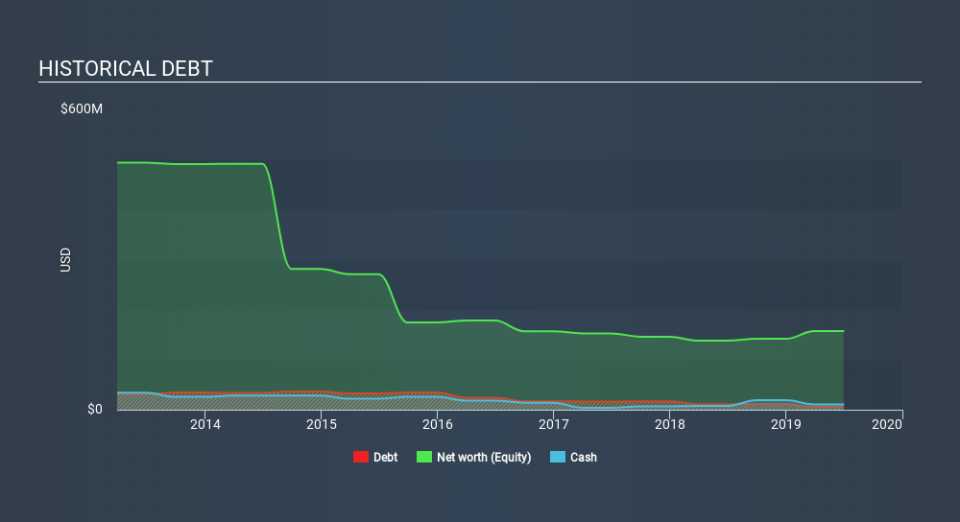Does JKX Oil & Gas (LON:JKX) Have A Healthy Balance Sheet?

David Iben put it well when he said, 'Volatility is not a risk we care about. What we care about is avoiding the permanent loss of capital. So it might be obvious that you need to consider debt, when you think about how risky any given stock is, because too much debt can sink a company. As with many other companies JKX Oil & Gas plc (LON:JKX) makes use of debt. But the real question is whether this debt is making the company risky.
What Risk Does Debt Bring?
Debt assists a business until the business has trouble paying it off, either with new capital or with free cash flow. Ultimately, if the company can't fulfill its legal obligations to repay debt, shareholders could walk away with nothing. However, a more common (but still painful) scenario is that it has to raise new equity capital at a low price, thus permanently diluting shareholders. Having said that, the most common situation is where a company manages its debt reasonably well - and to its own advantage. The first thing to do when considering how much debt a business uses is to look at its cash and debt together.
Check out our latest analysis for JKX Oil & Gas
What Is JKX Oil & Gas's Debt?
The image below, which you can click on for greater detail, shows that JKX Oil & Gas had debt of US$5.58m at the end of June 2019, a reduction from US$10.8m over a year. But it also has US$10.6m in cash to offset that, meaning it has US$5.04m net cash.
A Look At JKX Oil & Gas's Liabilities
According to the last reported balance sheet, JKX Oil & Gas had liabilities of US$35.8m due within 12 months, and liabilities of US$33.7m due beyond 12 months. Offsetting these obligations, it had cash of US$10.6m as well as receivables valued at US$4.73m due within 12 months. So it has liabilities totalling US$54.2m more than its cash and near-term receivables, combined.
When you consider that this deficiency exceeds the company's US$37.5m market capitalization, you might well be inclined to review the balance sheet intently. Hypothetically, extremely heavy dilution would be required if the company were forced to pay down its liabilities by raising capital at the current share price. Given that JKX Oil & Gas has more cash than debt, we're pretty confident it can handle its debt, despite the fact that it has a lot of liabilities in total.
In addition to that, we're happy to report that JKX Oil & Gas has boosted its EBIT by 34%, thus reducing the spectre of future debt repayments. There's no doubt that we learn most about debt from the balance sheet. But ultimately the future profitability of the business will decide if JKX Oil & Gas can strengthen its balance sheet over time. So if you want to see what the professionals think, you might find this free report on analyst profit forecasts to be interesting.
Finally, while the tax-man may adore accounting profits, lenders only accept cold hard cash. JKX Oil & Gas may have net cash on the balance sheet, but it is still interesting to look at how well the business converts its earnings before interest and tax (EBIT) to free cash flow, because that will influence both its need for, and its capacity to manage debt. Looking at the most recent two years, JKX Oil & Gas recorded free cash flow of 44% of its EBIT, which is weaker than we'd expect. That's not great, when it comes to paying down debt.
Summing up
While JKX Oil & Gas does have more liabilities than liquid assets, it also has net cash of US$5.04m. And we liked the look of last year's 34% year-on-year EBIT growth. So we are not troubled with JKX Oil & Gas's debt use. When analysing debt levels, the balance sheet is the obvious place to start. But ultimately, every company can contain risks that exist outside of the balance sheet. To that end, you should be aware of the 4 warning signs we've spotted with JKX Oil & Gas .
When all is said and done, sometimes its easier to focus on companies that don't even need debt. Readers can access a list of growth stocks with zero net debt 100% free, right now.
If you spot an error that warrants correction, please contact the editor at editorial-team@simplywallst.com. This article by Simply Wall St is general in nature. It does not constitute a recommendation to buy or sell any stock, and does not take account of your objectives, or your financial situation. Simply Wall St has no position in the stocks mentioned.
We aim to bring you long-term focused research analysis driven by fundamental data. Note that our analysis may not factor in the latest price-sensitive company announcements or qualitative material. Thank you for reading.

 Yahoo Finance
Yahoo Finance 
